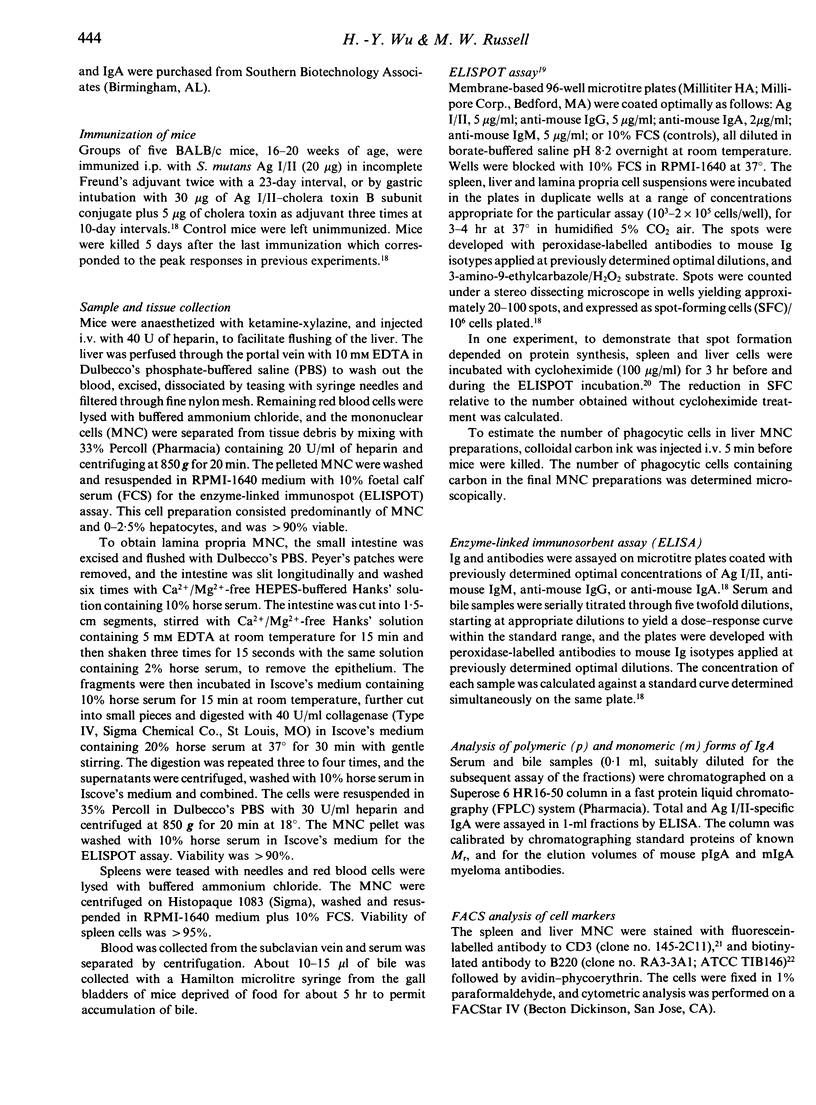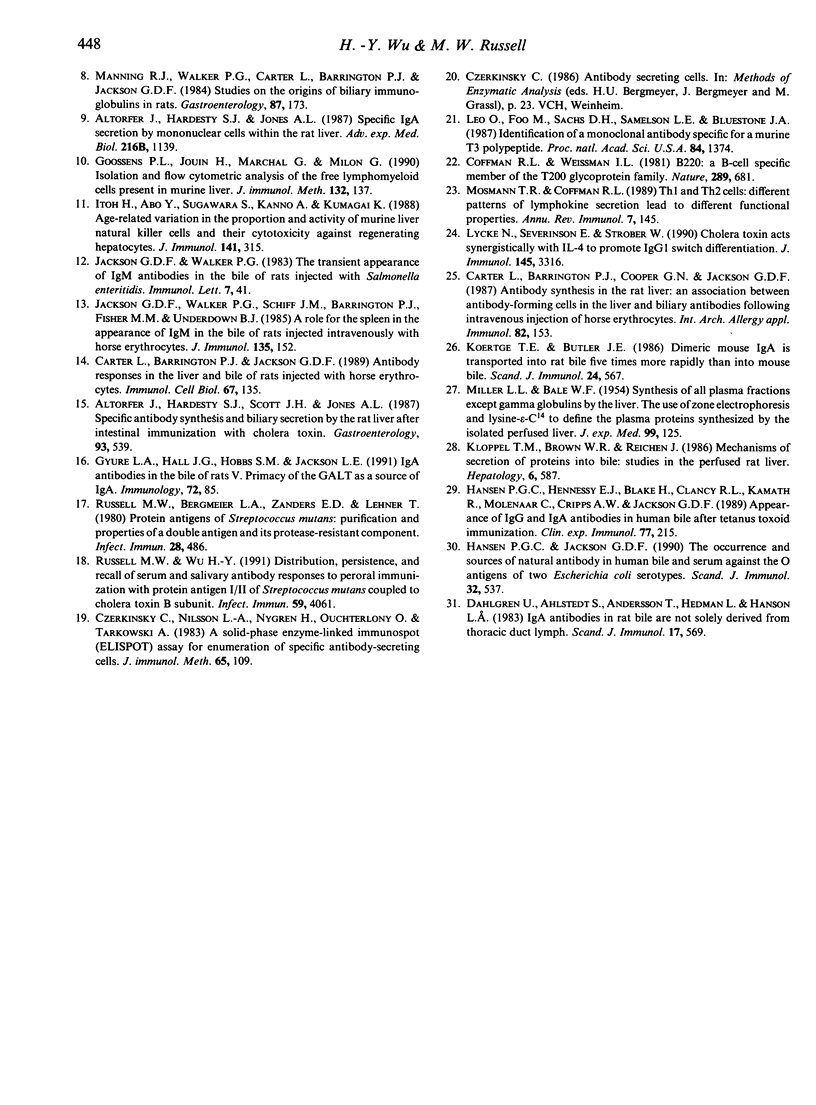Abstract
To elucidate the origins of biliary IgA antibodies, we investigated the isotype and specificity of antibody-secreting cells (ASC) in the liver in comparison with the spleen and intestinal lamina propria of mice immunized by peroral or parenteral routes. The profile of specific IgM, IgG1, IgG2a, and IgA ASC in the liver resembled that of the spleen rather than the lamina propria, regardless of the route of immunization. Peroral immunization increased the proportion of specific IgA ASC in all three organs. However, liver mononuclear cells (MNC) contained a higher proportion of total IgA-secreting cells than spleen cells. After immunization, the number and proportion of B220+ B cells were increased in the liver but not in the spleen. Although the predominant isotype of Ig and specific antibody in bile in response to immunization by either route was IgA, IgM and IgG were clearly detectable. However, specific activities of biliary antibodies relative to total Ig isotype were generally higher than in serum. The predominance of IgA-secreting cells in the liver and the large amount of IgA secreted in the bile resemble the situation at other secretory sites of the mucosal immune system. However, specific antibody-secreting cells appear to accumulate in the liver promptly after immunization, regardless of isotype, and contribute locally produced antibodies to the bile.
Full text
PDF





Selected References
These references are in PubMed. This may not be the complete list of references from this article.
- Altorfer J., Hardesty S. J., Jones A. L. Specific IgA secretion by mononuclear cells within the rat liver. Adv Exp Med Biol. 1987;216B:1139–1145. [PubMed] [Google Scholar]
- Altorfer J., Hardesty S. J., Scott J. H., Jones A. L. Specific antibody synthesis and biliary secretion by the rat liver after intestinal immunization with cholera toxin. Gastroenterology. 1987 Sep;93(3):539–549. doi: 10.1016/0016-5085(87)90917-6. [DOI] [PubMed] [Google Scholar]
- Carter L., Barrington P. J., Cooper G. N., Jackson G. D. Antibody synthesis in the rat liver: an association between antibody-forming cells in the liver and biliary antibodies following intravenous injection of horse erythrocytes. Int Arch Allergy Appl Immunol. 1987;82(2):153–158. doi: 10.1159/000234181. [DOI] [PubMed] [Google Scholar]
- Carter L., Barrington P. J., Jackson G. D. Antibody responses in the liver and bile of rats injected with horse erythrocytes. Immunol Cell Biol. 1989 Apr;67(Pt 2):135–139. doi: 10.1038/icb.1989.19. [DOI] [PubMed] [Google Scholar]
- Coffman R. L., Weissman I. L. B220: a B cell-specific member of th T200 glycoprotein family. Nature. 1981 Feb 19;289(5799):681–683. doi: 10.1038/289681a0. [DOI] [PubMed] [Google Scholar]
- Czerkinsky C. C., Nilsson L. A., Nygren H., Ouchterlony O., Tarkowski A. A solid-phase enzyme-linked immunospot (ELISPOT) assay for enumeration of specific antibody-secreting cells. J Immunol Methods. 1983 Dec 16;65(1-2):109–121. doi: 10.1016/0022-1759(83)90308-3. [DOI] [PubMed] [Google Scholar]
- Dahlgren U., Ahlstedt S., Andersson T., Hedman L., Hanson L. A. IgA antibodies in rat bile are not solely derived from thoracic duct lymph. Scand J Immunol. 1983 Jun;17(6):569–574. doi: 10.1111/j.1365-3083.1983.tb00825.x. [DOI] [PubMed] [Google Scholar]
- Dolezel J., Bienenstock J. Immune response of the hamster to oral and parenteral immunization. Cell Immunol. 1971 Aug;2(4):326–334. doi: 10.1016/0008-8749(71)90067-0. [DOI] [PubMed] [Google Scholar]
- Goossens P. L., Jouin H., Marchal G., Milon G. Isolation and flow cytometric analysis of the free lymphomyeloid cells present in murine liver. J Immunol Methods. 1990 Aug 28;132(1):137–144. doi: 10.1016/0022-1759(90)90407-m. [DOI] [PubMed] [Google Scholar]
- Hadziyannis S., Feizi T., Scheuer P. J., Sherlock S. Immunoglobulin-containing cells in the liver. Clin Exp Immunol. 1969 Nov;5(5):499–514. [PMC free article] [PubMed] [Google Scholar]
- Hansen P. G., Hennessy E. J., Blake H., Clancy R. L., Kamath R., Molenaar C., Cripps A. W., Jackson G. D. Appearance of IgG and IgA antibodies in human bile after tetanus toxoid immunization. Clin Exp Immunol. 1989 Aug;77(2):215–220. [PMC free article] [PubMed] [Google Scholar]
- Hansen P. G., Jackson G. D. The occurrence and sources of natural antibody in human bile and serum against the O antigens of two Escherichia coli serotypes. Scand J Immunol. 1990 Nov;32(5):537–544. doi: 10.1111/j.1365-3083.1990.tb03194.x. [DOI] [PubMed] [Google Scholar]
- Henderson L. A., Baynes J. W., Thorpe S. R. Identification of the sites of IgG catabolism in the rat. Arch Biochem Biophys. 1982 Apr 15;215(1):1–11. doi: 10.1016/0003-9861(82)90272-7. [DOI] [PubMed] [Google Scholar]
- Hiramoto R. N., Habeeb A. F., Hamlin M. Antibody-forming cells in five organs of hyperimmunized guinea pigs. Proc Soc Exp Biol Med. 1970 Sep;134(4):975–979. doi: 10.3181/00379727-134-34924. [DOI] [PubMed] [Google Scholar]
- Itoh H., Abo T., Sugawara S., Kanno A., Kumagai K. Age-related variation in the proportion and activity of murine liver natural killer cells and their cytotoxicity against regenerating hepatocytes. J Immunol. 1988 Jul 1;141(1):315–323. [PubMed] [Google Scholar]
- Jackson G. D., Walker P. G., Schiff J. M., Barrington P. J., Fisher M. M., Underdown B. J. A role for the spleen in the appearance of IgM in the bile of rats injected intravenously with horse erythrocytes. J Immunol. 1985 Jul;135(1):152–157. [PubMed] [Google Scholar]
- Jackson G. D., Walker P. G. The transient appearance of IgM antibodies in the bile of rats injected with Salmonella enteritidis. Immunol Lett. 1983;7(1):41–45. doi: 10.1016/0165-2478(83)90053-6. [DOI] [PubMed] [Google Scholar]
- Kearney J. F., Lawton A. R. B lymphocyte differentiation induced by lipopolysaccharide. II. Response of fetal lymphocytes. J Immunol. 1975 Sep;115(3):677–681. [PubMed] [Google Scholar]
- Kloppel T. M., Brown W. R., Reichen J. Mechanisms of secretion of proteins into bile: studies in the perfused rat liver. Hepatology. 1986 Jul-Aug;6(4):587–594. doi: 10.1002/hep.1840060407. [DOI] [PubMed] [Google Scholar]
- Koertge T. E., Butler J. E. Dimeric mouse IgA is transported into rat bile five times more rapidly than into mouse bile. Scand J Immunol. 1986 Nov;24(5):567–574. doi: 10.1111/j.1365-3083.1986.tb02172.x. [DOI] [PubMed] [Google Scholar]
- Leo O., Foo M., Sachs D. H., Samelson L. E., Bluestone J. A. Identification of a monoclonal antibody specific for a murine T3 polypeptide. Proc Natl Acad Sci U S A. 1987 Mar;84(5):1374–1378. doi: 10.1073/pnas.84.5.1374. [DOI] [PMC free article] [PubMed] [Google Scholar]
- Lycke N., Severinson E., Strober W. Cholera toxin acts synergistically with IL-4 to promote IgG1 switch differentiation. J Immunol. 1990 Nov 15;145(10):3316–3324. [PubMed] [Google Scholar]
- MILLER L. L., BALE W. F. Synthesis of all plasma protein fractions except gamma globulins by the liver; the use of zone electrophoresis and lysine-epsilon-C14 to define the plasma proteins synthesized by the isolated perfused liver. J Exp Med. 1954 Feb;99(2):125–132. doi: 10.1084/jem.99.2.125. [DOI] [PMC free article] [PubMed] [Google Scholar]
- Manning R. J., Walker P. G., Carter L., Barrington P. J., Jackson G. D. Studies on the origins of biliary immunoglobulins in rats. Gastroenterology. 1984 Jul;87(1):173–179. [PubMed] [Google Scholar]
- Mestecky J., Lue C., Russell M. W. Selective transport of IgA. Cellular and molecular aspects. Gastroenterol Clin North Am. 1991 Sep;20(3):441–471. [PubMed] [Google Scholar]
- Moldoveanu Z., Moro I., Radl J., Thorpe S. R., Komiyama K., Mestecky J. Site of catabolism of autologous and heterologous IgA in non-human primates. Scand J Immunol. 1990 Dec;32(6):577–583. doi: 10.1111/j.1365-3083.1990.tb03199.x. [DOI] [PubMed] [Google Scholar]
- Mosmann T. R., Coffman R. L. TH1 and TH2 cells: different patterns of lymphokine secretion lead to different functional properties. Annu Rev Immunol. 1989;7:145–173. doi: 10.1146/annurev.iy.07.040189.001045. [DOI] [PubMed] [Google Scholar]
- Russell M. W., Bergmeier L. A., Zanders E. D., Lehner T. Protein antigens of Streptococcus mutans: purification and properties of a double antigen and its protease-resistant component. Infect Immun. 1980 May;28(2):486–493. doi: 10.1128/iai.28.2.486-493.1980. [DOI] [PMC free article] [PubMed] [Google Scholar]
- Russell M. W., Wu H. Y. Distribution, persistence, and recall of serum and salivary antibody responses to peroral immunization with protein antigen I/II of Streptococcus mutans coupled to the cholera toxin B subunit. Infect Immun. 1991 Nov;59(11):4061–4070. doi: 10.1128/iai.59.11.4061-4070.1991. [DOI] [PMC free article] [PubMed] [Google Scholar]


